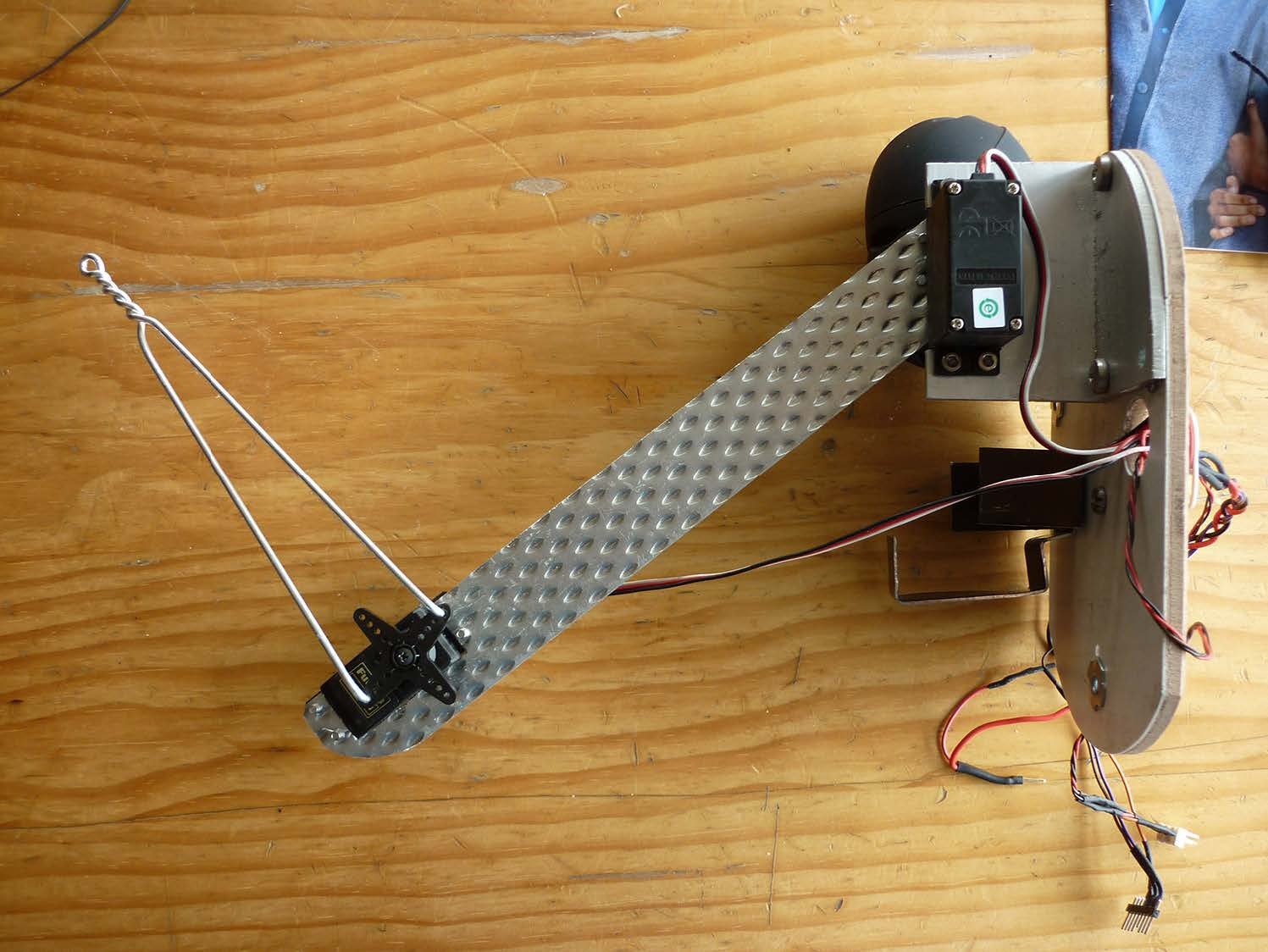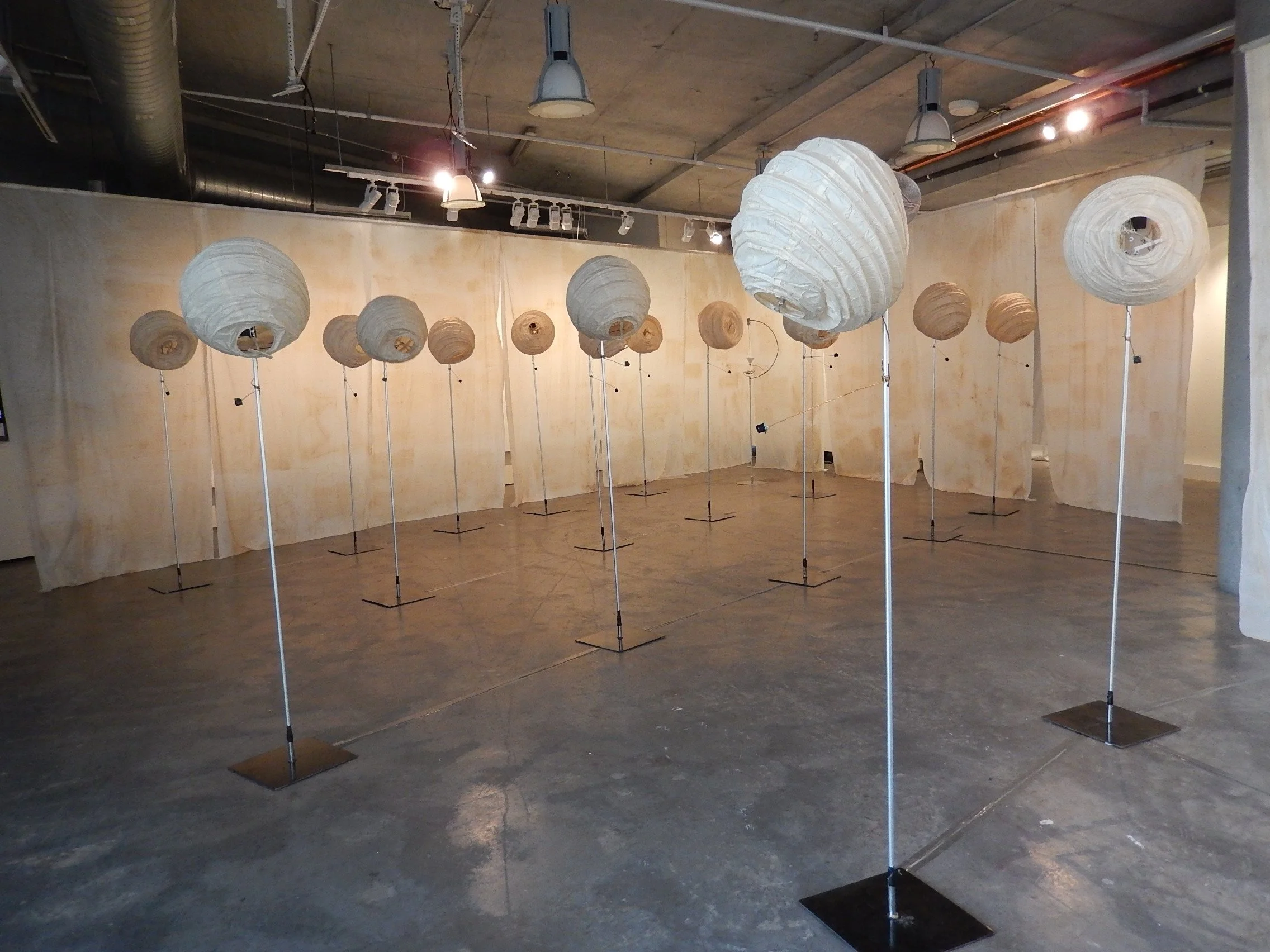Downwind
Raewyn Turner & Brian Harris 2013
Downwind 2013. Raewyn Turner & Brian Harris. Installation ISEA
Downwind: Raewyn Turner & Brian Harris 2013
The Downwind installation combines art, engineering and science research and is composed of twenty pods that sense human presence and respond by breathing smells on the audience. The whole of nature is communicating with olfactory signals largely disregarded by humans despite their measurable effects on human behaviour and emotions.
The pods sense human presence and respond by expressing controlled delivery of 20 specifically chosen smell compounds in calibrated amounts via a programmed mechanism that uses arduinos, servo motors, ultrasonic distance sensors. The smell compounds that the pods exhale are ones known to elicit specific anosmias ( loss of sense of smell ) for some, and not for others. List of olfactory compounds here ( 2013). Backdrop painting: Stockholm tar and plastic.
Downwind explores our differences in olfactory sensitivity and selectivity due to the genetic basis of human olfactory variability and the perception of odiferous sequences in changed contexts. The revolutionary wind of genetic discovery suggests that we may not all be perceiving the same reality.
The pod array expresses a body of interactive and programmed robotics dressed in chinese paper lampshades to express precisely calibrated amounts of smells. Each lampshade houses a pump that expresses a mixture of air and smell molecules in a certain ratio via articulated arms controlled by servos controlled by a microprocessor programmed to correspond to ultrasonic distances. When activated the mechanism delivers a concentration of smell without leaving a residual smell, allowing the experiences and perception of difference, similarity and sequence of odiferous materials. Since 1952 when Ernest Beaux, perfumer wrote ‘The future of perfumery is in the hands of chemistry’ many novel olfactory molecules have been designed and created for the perfuming and deodorising of bodies, possessions, environment and food, as well as technological means to detect them. Olfactory molecules by nature are aerosols. Contemporary studies of biological aerosol particles, scientifically investigated since the nineteenth century, may lead to a better understanding of their role in climate and atmospheric processes and may also help to improve understanding of their impacts on humans.
According to Despre et al., 2011, efficient and reliable analytical techniques must be developed for the identification and quantification of primary biological aerosol particles, PBAPs, as well as for the determination of the abundance and diversity of PBAPs and their seasonal variation on regional and global scales (atmospheric biogeography), to anchor models in a solid empirical foundation. (i) Eschewing a nostalgic longing for the past this project enquires about the physical sensing of novel materials at a time when olfactory and gustatory perceptions of the environment, the air, cities, clothing, and the way that we perceive ourselves are being extensively altered by the natural and engineered olfactory cyphers. Further changes may also be experienced in the extra synthetic airborne particles as they undergo modifications while airborne: hygroscopic, growth, deliquescence, reactions with other acids and gases, condensation, alterations of optical properties, coagulation, and ageing. The potential to perceive the information of these new chemical technologies not just with the nose but with the gut may be realised through practicing olfactory observation, noting the feelings and emotions that arise from particular smells. In both the nose and the gut where there are also taste and olfactory receptors it is the region that gives rise to enteric knowledge or gut feeling. (ii)…More information about Downwind here pdf download
Humans, animals and insects are immersed in an atmospheric ocean of olfactory cues which are in dynamic flux with olfactory perception. At first the phenomena of smell may seem insignificant but humans are bound up in the transpiration and consumption/absorption of olfactory particles. Emerging as vapours into the troposphere, fragrances arise from cultural, social and political systems that have engineered the landscapes and thus mindscapes into settlements, habitations, fields, factories, front lawns and streets.
Downwind explores our differences and preferences in olfactory sensitivity and selectivity, and the perception of odiferous sequences. It may be possible to retrain our declining sense of smell to perceive the cyphers of chemical signals not just with the nose but with the gut and to note the feelings and emotions that arise from olfactory materials, whether natural, synthetic or engineered.
Is a visceral comprehension possible in a sanitised and deodorised olfactory environment suffused with new synthetic olfactory molecular architectures for smell and taste? Synthesised and novel particles may affect microbes and thus by implication the immune system which establishes a distinction between self and other which eventually transforms the behaviour of living beings.
Not only are synthetic olfactory molecules changing perception of the world, but technologies are changing perception. Whether natural, synthetic or engineered, they are the olfactory cyphers of change, yet sensing them is defined by a combination of genetics and personal experiences. To increase our ability to perceive the information of new chemical signals not just with the nose but with the gut it may be necessary to retrain one's olfactory observation and to note the feelings and emotions that arise from olfactory materials.
Jack Ox's discussion about Downwind in her final dissertation. ‘The literature review- chapter 2 covers and orders conceptual metaphor theory and conceptual blending theory into a taxonomy that is very useful for cross-modal mapping. Chapter 3 is all about intermedia and multimodal entities. Then chapter 5-10 reexplains the parts of the lit review with analysis of examples- I examine Raewyn’s olfactory work in the chapter on conceptual blending.’
READ more WWW.academia.edu
We made two interactive sugar-dispensing devices. A little sugar on your tongue may help amplify your sense of smell. When you place your hand on the dish it activates the silver wrecking ball spins in the sugar cone which drops a few sugar grains into your hand.

Developing the mechanisms and structures.

Assembling the robot arms

We tried out varios sizes and shapes of paper lanterns and this oval shape was suitable

The Pod robotic mechanism which animates the paper lampshades
Thanks to Richard Newcomb, Plant and Food Research, Monell Chemical Senses Center, USA., Creative New Zealand, ISEA, Chris Davison
Please find more information at KissingBees Journal
2012 Downwind First Prize Art sculpture Awards.The Trusts, Waitakere
2013 Exhibited in ISEA public program Resistance is Futile: Curatorial Theme: : Ecologies and Technologies. with funding from Creative New Zealand
2015 Presentation Downwind : Investigating Smell and the Images and Feelings it Evokes at V Congreso International de Sinestesia, Ciencia Y Arte 2015. Andalucia, Spain.
2016. Presentation Downwind : Code Biology Conference, Urbino, Italy, 24-28 May, 2016
2016 Downwind presented in a series of exhibitions in China 1st Synaesthesia Art Exhibition and Forum in China during the project events in Beijing, Xu Zhou and Hang Zhou in 2016.
2024 Exhibited in ‘Smells Like Roses’ International Olfactory Art. Te Awahou Nieuwe Stroom, Māpuna Kabinet Art Gallery, Foxton
ARTECITTA International Foundation : Synaesthesia Science and Art
Chinese Synaesthesia Alliance in Wei Xin Media







